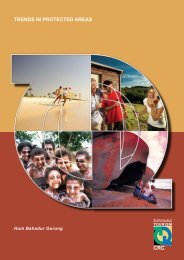icolls - Sustainable Tourism CRC
icolls - Sustainable Tourism CRC
icolls - Sustainable Tourism CRC
You also want an ePaper? Increase the reach of your titles
YUMPU automatically turns print PDFs into web optimized ePapers that Google loves.
ECOLOGY, THREATS AND MANAGEMENT OPTIONS FOR SMALL ESTUARIES AND ICOLLS<br />
Chapter 4<br />
COMPARISON OF DIETS OF FOUR COMMERCIALLY AND<br />
RECREATIONALLY IMPORTANT FISH SPECIES IN TWO<br />
ICOLLS IN NORTHERN NEW SOUTH WALES<br />
Abstract<br />
<strong>Tourism</strong> and recreation in and around ICOLLS often revolves around their suitability as sites for recreational<br />
fishing. In this component of the project, we sampled commercially and recreationally significant fish species<br />
from two ICOLLs in northern New South Wales. Our objective was to assess the diets of yellowfin bream<br />
(Acanthopagrus australis), dusky flathead (Platycephalus fuscus), sand whiting (Sillago ciliata) and sea mullet<br />
(Mugil cephalus) and compare them against literature data from permanently open estuaries.<br />
All four target species demonstrated a narrower dietary breadth in the study systems when compared to<br />
literature data for estuaries within the same geographic region. In addition, we found that for the opportunistic<br />
predator species (A. australis, P. fuscus and S. ciliata), diets tended to reflect apparent preferential feeding on<br />
abundant prey items, despite the availability of a wider range of invertebrate taxa. A. australis had the most<br />
diverse diet of the four species analysed, suggesting a generalist feeding strategy that enables it to flourish in<br />
ICOLL habitats. Discrepancies between estuarine literature and our findings were most significant for S. ciliata,<br />
as we found decapod crustaceans (a reportedly very significant component of the diet) to be completely absent<br />
from most guts and replaced, in terms of abundance and biomass, by polychaete worms. Significantly, we<br />
sampled reasonable numbers of decapods from both ICOLLs and suggest that S. ciliata diets are influenced by<br />
availability as well as ease of capture.<br />
The differences in dietary compositions of commercially and recreationally valuable fish species between the<br />
two study ICOLLs and permanently open estuaries (assessed from literature data) revealed that for these four<br />
species, ICOLLs support unique trophic pathways that are strongly mediated by the variable connectivity with<br />
the ocean. The impact of artificial opening regimes on teleost species and prey assemblages is therefore<br />
important when considering the recreationally and commercially valuable fisheries supported by these abundant<br />
coastal environments.<br />
In contrast to permanently open estuaries, ICOLLs are characterised by few or no true seagrasses, and tend to<br />
be dominated by Ruppia spp. (sea tassel) and a wide variety of algal species (Pollard 1994a). In addition the<br />
diversity and distribution of vegetation is another significant difference between ICOLLs and permanently open<br />
estuaries. ICOLLs tend to have higher densities of algal species and have fringing wetlands dominated by<br />
Casuarinas and Melaleucas with few mangrove species (Lugg, Williams, Fairfull & Grey 1998).<br />
Salinity levels in ICOLLs are highly variable and are best described as poikilosaline, emphasising the<br />
importance of variation rather than absolute levels (Bayly 1980). Loneragan, Potter and Lenanton (1989)<br />
demonstrated a distinct change in the relative contribution of marine, estuarine and freshwater ichthyofauna over<br />
the salinity gradient of an open estuary but salinity levels in these systems are comparatively stable. Salinity<br />
stability is known to be an important factor that influences an ICOLL’s ability to support both marine and<br />
estuarine fishes (Griffiths 2001). For example, temporal and spatial variations in the salinity of an ICOLL,<br />
resulting from extended periods of closure, rainfall events and bar breaching, can cause a shift in ichthyofauna<br />
composition and abundance (Young et al. 1997; Young and Potter 2002). Macroinvertebrate communities have<br />
also been shown to respond to changes in salinity, indicating that the contribution of prey types to fish diets is<br />
likely to be a function of their response to salinity regimes (Williams & Williams 1998).<br />
The differences between permanently open estuaries and ICOLLs in terms of community composition,<br />
physiochemical properties and marine, terrestrial and freshwater influences suggests that unique dietary<br />
compositions and food webs may exist in these systems. Work across a variety of open and intermittently open<br />
systems in Western Australia has already shown this to be the case, with the dietary composition of<br />
Acanthopagrus butcheri individuals differing significantly between sites (Sarre, Platell & Potter 2000). In<br />
addition to differences between systems, upstream shifts in dietary composition have also been detected in larger<br />
systems (Sarre, Platell & Potter 2000). Given their physical and chemical variability, ICOLLs may only support<br />
species that are opportunists and/or generalists in their feeding habits, enabling them to shift readily between<br />
prey items based on the dynamic nature of their availability in these systems.<br />
Differences in resources between natural wetlands (seagrass) and artificial waterways (algae) have recently<br />
been shown to affect diet composition of a garfish and a sallaginid species (Connolly 2003). A similar difference<br />
36











